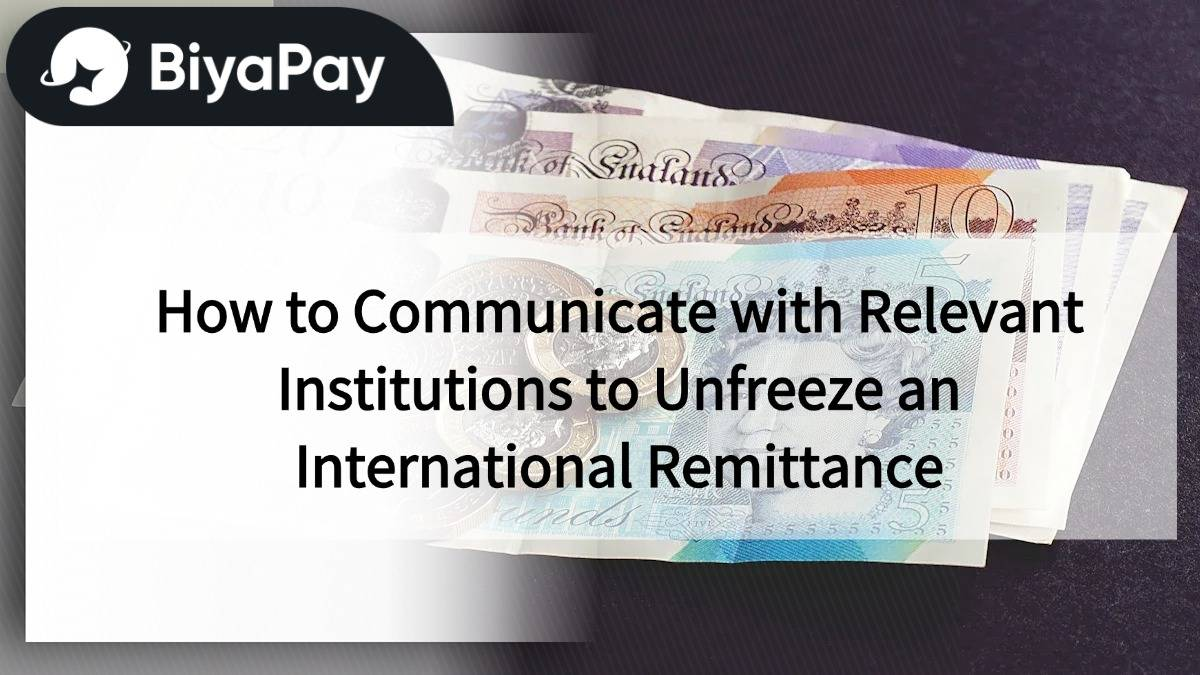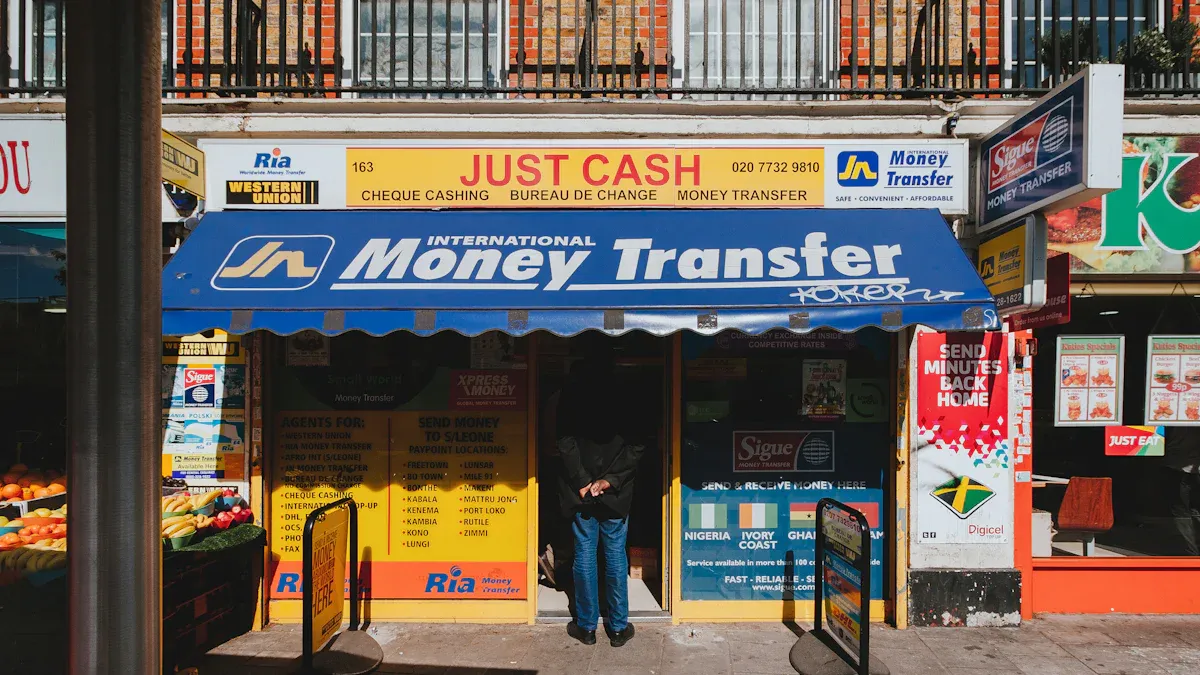- EasyCard
- Trade
- Help
- Announcement
- Academy
- SWIFT Code
- Iban Number
- Referral
- Customer Service
- Blog
- Creator
How to Communicate with Relevant Institutions to Unfreeze an International Remittance

Image Source: pexels
When an international remittance is frozen, you need to take swift action. First, identifying the reason for the freeze is the foundation for unfreezing. Second, preparing complete documents helps expedite the process. When communicating with relevant institutions, please provide accurate information and remain patient. If you don’t know what to do when an international remittance is frozen, consider consulting professionals or bank customer service for tailored advice.
Analysis of Freeze Reasons
Common Reasons for Freezing
International remittances are typically frozen due to the following reasons:
- Transaction behavior triggers the risk control system. This accounts for the highest proportion, reaching 58%.
- Expired identity verification documents, accounting for 23%.
- Abnormal logins from multiple devices, accounting for 12%.
- Risk transmission from associated accounts, accounting for 7%.
Below is a statistical table of the proportion of each reason:
| Freeze Reason | Proportion |
|---|---|
| Transaction behavior triggers risk control system | 58% |
| Expired identity verification documents | 23% |
| Abnormal logins from multiple devices | 12% |
| Risk transmission from associated accounts | 7% |
Additionally, a bar chart can visually display this data:
How to Confirm the Freeze Reason
Confirming the freeze reason is the first step in the unfreezing process. You can confirm it through the following methods:
- Contact the remitting bank to obtain a detailed explanation of the freeze reason.
- Prepare relevant supporting documents, including invoices, payment instructions, transfer instructions, etc. Ensure the documents are authentic, accurate, and complete.
- If the freeze involves law enforcement agencies, refer to the application process instructions provided on the OFAC website.
These documents typically include: business license, legal representative’s ID, and the reason and purpose of the international remittance. By communicating with the bank or relevant institutions, you can quickly identify the specific reason for the freeze.
Impact of Freeze Reasons on the Unfreezing Process
The freeze reason directly affects the unfreezing time and process. Below are the potential processing changes caused by different reasons:
- If the account has been inactive for a long time or has abnormal fund flows, the account holder must personally visit a bank counter to handle unfreezing procedures.
- If the account is frozen due to law enforcement agencies, you need to cooperate with case handling, and the unfreezing time may be longer.
- Freezes triggered by risk control systems usually require submitting additional identity verification documents, with shorter processing times.
After understanding the freeze reason, you can take targeted measures based on the specific situation to accelerate the unfreezing process. If you are still unsure about what to do when an international remittance is frozen, you can consult bank customer service or professionals for assistance.
Specific Steps to Unfreeze an International Remittance

Image Source: pexels
Step 1: Contact Relevant Institutions
When you discover that an international remittance is frozen, you need to immediately contact the relevant institutions. The first choice is the remitting bank, such as the customer service department of a Hong Kong bank. They typically provide 24-hour service and can quickly help you understand the account status. When calling the bank’s customer service hotline, prepare your account information and remittance details. These details include the remittance amount, time, and recipient information. Through phone or online customer service, you can obtain initial guidance and clarify the next steps.
Step 2: Verify the Freeze Reason
Verifying the freeze reason is a critical step in the unfreezing process. You can request the bank to provide the specific reason for the freeze and relevant clause explanations. For example, according to relevant Chinese legal provisions, the following clauses may involve freezing measures:
| Clause | Content |
|---|---|
| Article 55 | During preliminary verification, supervisory authorities may legally impose freezing measures. |
| Article 6 | Investigation and evidence collection work, such as interrogation and searches, should be recorded and videotaped in full. |
| Article 9 | Materials that can be used to prove case facts include physical evidence, documentary evidence, etc. |
| Article 10 | When inquiring or freezing assets, there must be no fewer than two investigators. |
Through these clauses, you can determine whether the freeze involves law enforcement agencies or risk control systems. If the freeze reason is unclear, it is recommended to request a written explanation from the bank for further processing.
Step 3: Prepare Required Documents
Based on the freeze reason, you need to prepare the relevant documents. Common documents include:
- Identity proof documents, such as a passport or ID card.
- Remittance-related documents, such as invoices, payment instructions, or contracts.
- Business license and legal representative’s ID for corporate accounts (if applicable).
Ensure all documents are authentic, complete, and meet requirements. If the freeze involves law enforcement agencies, additional case-related proof documents may be required. Preparing these documents in advance can avoid repeated submissions and save time.
Step 4: Submit Unfreezing Application
After preparing the documents, you need to submit an unfreezing application to the relevant institution. Typically, banks provide online or offline application channels. For online applications, upload documents and fill out the application form. For offline applications, you need to visit a bank counter in person. When submitting the application, ensure the information is accurate. If the application involves law enforcement agencies, you may need to submit it with the assistance of a lawyer to ensure compliance.
Step 5: Follow Up on Application Progress
Regularly following up on progress is crucial after submitting the application. You can check the application status through bank customer service or online systems. If the application takes longer to process, it is recommended to proactively contact the bank to inquire whether additional documents or further verification are needed. Understanding the processing timelines of different institutions is also important. For example, Hong Kong banks typically complete reviews within 5 business days, while law enforcement agencies may take longer. Staying patient and actively following up can improve unfreezing efficiency.
Communication Techniques with Relevant Institutions

Image Source: unsplash
How to Clearly Express the Issue
When communicating with relevant institutions, clearly expressing the issue is key. You need to describe the situation concisely and clearly, avoiding complex language or lengthy sentences. Below are some practical techniques:
- Clarify the Core Issue: For example, directly state, “My international remittance has been frozen, and I need to understand the reason and apply to unfreeze it.”
- Provide Specific Details: Include remittance amount, time, recipient information, etc.
- Use Logical Order: Arrange information by chronological order or importance to make it easier for the other party to understand.
Tip: Writing down the key points of the issue in advance can help you stay organized during communication.
Provide Complete and Accurate Information
Providing complete and accurate information is the foundation for resolving issues. You need to ensure all documents and data are authentic and error-free. Below are some suggestions:
- Verify Documents: Carefully check IDs, remittance receipts, etc., for errors or omissions before submission.
- Avoid Vague Descriptions: For example, instead of saying “it might be some reason,” clearly state, “According to bank customer service feedback, the freeze is due to expired identity verification documents.”
- Supplement Necessary Documents: If the bank requires additional proof, such as contracts or invoices, prepare and submit them promptly.
Note: Incomplete or incorrect information may lead to application rejection, prolonging the unfreezing time.
Avoid Common Communication Pitfalls
Avoiding common pitfalls during communication with relevant institutions can improve efficiency. Below are some points to note:
- Pitfall 1: Emotional Expression: Stay calm and avoid using aggressive language or emotional tones.
- Pitfall 2: Repeated Document Submission: Repeated submissions may cause processing delays; ensure each submission meets requirements.
- Pitfall 3: Ignoring Communication Records: Record the time, content, and other party’s feedback for each communication for future follow-ups.
Tip: If you’re unsure about what to do when an international remittance is frozen, consult professionals to avoid wasting time due to misunderstandings.
How to Handle Complex Situations
When encountering complex situations, you need to take more targeted measures. Below are some coping strategies:
- Multi-Channel Communication: In addition to bank customer service, contact relevant law enforcement agencies or lawyers for more information.
- Seek Professional Help: If the freeze reason involves legal issues, hiring a lawyer can help resolve the issue faster.
- Stay Patient: Complex situations may require more time to process; regularly follow up on application progress to ensure the issue isn’t overlooked.
Tip: Complex situations often require more documents and time; preparing in advance can reduce unnecessary trouble.
Precautions During the Unfreezing Process
Comply with Laws and Regulations
Complying with relevant laws and regulations is crucial when unfreezing an international remittance. You need to understand the financial regulatory requirements of the country or region involved. For example, China’s Anti-Money Laundering Law and Foreign Exchange Management Regulations have clear provisions for international remittances. Ensuring your actions comply with these legal requirements can avoid unnecessary trouble. If the freeze involves law enforcement agencies, you need to cooperate with investigations and provide required documents. Any attempt to evade legal requirements may lead to more severe consequences.
Retain Communication Records
Retaining communication records is an important step throughout the unfreezing process. You can document the content of each communication with banks or relevant institutions, including the time, the other party’s name, and the information provided. These records not only aid in follow-ups but can also serve as evidence if needed. Below are relevant legal clause explanations:
| Clause | Content |
|---|---|
| Article 56 | Investigation and evidence collection work, such as interrogation, searches, seizures, and detentions, as well as important conversations and inquiries, should be synchronously recorded and videotaped in full, with the integrity of the recordings maintained. Recordings should be properly stored, promptly archived, and retained for reference. |
| Article 67 | Evidence materials collected and assets seized should be properly stored, with strict adherence to handover and retrieval procedures, regularly reconciled, and not used, exchanged, damaged, or disposed of improperly. |
| Article 68 | Physical evidence, documentary evidence, audiovisual materials, electronic data, inspection records, and appraisal opinions collected by administrative agencies during law enforcement and case investigations, if verified to meet legal requirements, can be used as evidence. |
By properly retaining these records, you can better handle complex situations and ensure a smooth unfreezing process.
Avoid Repeated Document Submission
Repeated document submission may cause processing delays. You need to carefully verify all documents before submitting to ensure their completeness and accuracy. If the bank or relevant institution requests additional documents, clarify the specific requirements before submitting. Avoid submitting irrelevant or duplicate documents to save time and improve efficiency.
Understand Processing Timelines of Different Institutions
Processing timelines may vary across institutions. Banks typically complete reviews within 5 to 7 business days, while freezes involving law enforcement agencies may take longer. You need to understand the processing procedures and timelines of relevant institutions in advance to avoid anxiety due to long wait times. If you’re unsure about what to do when an international remittance is frozen, consult bank customer service or professionals for more accurate information.
When unfreezing an international remittance, you need to follow several key steps. First, identify the freeze reason and ensure information accuracy. Second, prepare complete documents to avoid omissions. After submitting the application, regularly follow up on progress to ensure the issue isn’t overlooked. Efficient communication with relevant institutions is crucial. Stay patient and follow procedures to successfully resolve the question of what to do when an international remittance is frozen.
FAQ
1. What Should I Do If the Bank Rejects the Unfreezing Application?
You can request the bank to provide a detailed explanation of the rejection reason. Based on the feedback, supplement documents or revise the application and resubmit. If necessary, consult professionals or lawyers.
2. How Long Does an Unfreezing Application Usually Take?
Processing times vary by institution. Banks typically require 5 to 7 business days, while law enforcement agencies may take longer. You can check progress through customer service or online systems.
3. Through Which Channels Can I Submit an Unfreezing Application?
You can choose to submit online or visit a bank counter in person. Specific channels depend on bank policies; it’s recommended to consult customer service in advance for confirmation.
Tip: Preparing all documents in advance can save time and improve application efficiency.
In 2025, international remittances often face freezes due to risk controls, expired verification documents, or unusual login activities, causing delays and costly resolution processes. BiyaPay offers a secure, efficient solution to minimize freeze risks! Exchange over 30 fiat currencies and 200+ cryptocurrencies with transparent real-time rates, and benefit from transfer fees as low as 0.5% across 190+ countries, with same-day initiated, same-day delivered transfers. Sign up for BiyaPay in just one minute to access streamlined verification and swift transfers for tuition payments, living expenses, or US/HK stock investments. Plus, grow idle funds with a 5.48% annualized yield on flexible savings. BiyaPay leverages blockchain technology for secure transactions, backed by U.S. MSB and SEC licenses to ensure compliance and reduce freeze risks. Start now—join BiyaPay to enjoy seamless international transfers with peace of mind!
*This article is provided for general information purposes and does not constitute legal, tax or other professional advice from BiyaPay or its subsidiaries and its affiliates, and it is not intended as a substitute for obtaining advice from a financial advisor or any other professional.
We make no representations, warranties or warranties, express or implied, as to the accuracy, completeness or timeliness of the contents of this publication.




Contact Us
Company and Team
BiyaPay Products
Customer Services
is a broker-dealer registered with the U.S. Securities and Exchange Commission (SEC) (No.: 802-127417), member of the Financial Industry Regulatory Authority (FINRA) (CRD: 325027), member of the Securities Investor Protection Corporation (SIPC), and regulated by FINRA and SEC.
registered with the US Financial Crimes Enforcement Network (FinCEN), as a Money Services Business (MSB), registration number: 31000218637349, and regulated by FinCEN.
registered as Financial Service Provider (FSP number: FSP1007221) in New Zealand, and is a member of the Financial Dispute Resolution Scheme, a New Zealand independent dispute resolution service provider.



















